Harry Nadler
A Recollection
by John Hayes
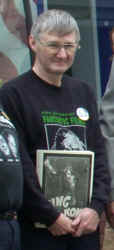
Harry Nadler
1941-2002 |
Before we go on to the next article, I’d just like to say a few words about its author. I first met Harry Nadler back in the early 1970s when he was running Delta Film Library in Salford - I used to rent 8mm films from him. We soon found that we had a common interest in science fiction and fantasy films, and would chat at length on that most fascinating of subjects. One day, the library closed, and I was not to meet Harry again until 1993, when a mutual interest in 3D brought us back into the same orbit. This time we did not lose touch and we became firm friends, sharing many an outing to cinemas and concerts with our wives, who were often bemused by the fact that we could discuss for hours the wonderful monster movies that we sometimes forced them to watch.
Harry’s contributions to fantasy fandom are too numerous to mention. From the legendary fanzines, L’Incroyable Cinema and Scary Dreams to the Festival of Fantastic Films, with Gil Lane-Young and Tony Edwards, his love of the genre shone through. In fact, Harry loved everything about film. If it was on celluloid, he collected it. Then VHS, then Laserdisc and lately DVD. He thought it was all wonderful, and his enthusiasm was infectious. Through Harry I became involved with Fantastic Films, and met many interesting people as a result. Ray Harryhausen and Forry Ackerman; writers Steve Laws, Jimmy Sangster and Brian Clemens, directors Val Guest and Norman J. Warren and actresses Hazel Court, Janette Scott and Janina Faye – very lovely ladies - to name just a few of the people whom they could persuade to attend the Convention. Many guests enjoyed it so much they came back again year after year. Harry made it fun.
When I mentioned to him the idea for this magazine, he embraced it with typical enthusiasm, offered his unqualified help and support, and so we planned it together. I asked him to write me an article, which is the one you will read here. Sadly, two days after he completed it, he died. Harry left this planet on 1st March 2002. Forbidden Planet - A Cinemascope SciFi Classic is his last contribution to the genre that he loved most of his life, and in his passing, the movies have lost one of their biggest fans, and he will not be forgotten. He was my friend.
Forbidden Planet
A CinemaScope Science Fiction Classic
by Harry Nadler
The first “grown-up” novel I ever read from cover to cover as a child was The War of the Worlds, which I found in the junior school library. It grabbed my imagination at exactly the right time and from that moment I was, without realising it, a science fiction fanatic. My youthful days of the 1950’s were also the birthplace of my love affair with the movies. However at that time the British censor decided that the films 1 wanted to see should almost always be labelled with an “X” certificate, for adult audiences only and so not permissible entertainment for a space-tripping, monster hungry 14-year-old.
My regular search of the evening newspaper’s cinema section in 1956 revealed very few new movies that I could get past the cinema staff to see. I looked so damn young for my age! Sunday programming in those distant days was the treasure-trove area for re-release films and I could often catch up with titles like Superman and the Mole Men, Invaders From Mars, Tobor the Great, The Lost Continent, Flight to Mars and The Man From Planet X as they all had the more accessible “A” certificates. But then came Forbidden Planet, which was not only a “U” certificate but was also in colour AND CinemaScope. This sounded like it was going to be an EVENT!
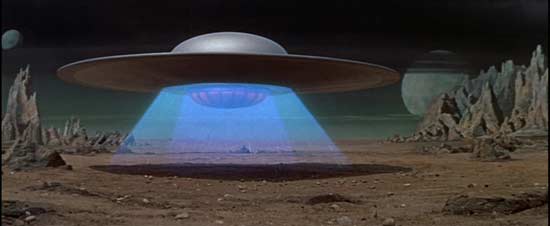
FP1 The space cruiser, C57D, lands on Altair IV. |
Set in the year of 2257, interplanetary United Planets’ Cruiser C57D reaches its destination, the planet Altair IV, with the prime objective of rescuing the crew of an earlier mission that had crashed on the barren world. The ship’s crew, headed by Commander John J. Adams (Leslie Nielsen) discover that there is only one survivor still alive from the earlier expedition, Dr. Edward Morbius (Walter Pidgeon). Morbius has a beautiful daughter, Altaira (Anne Francis) who was born after the crash. The story also involves a wonderful robot, Robby, one of the great screen robots of all time and now an icon of science fiction cinema. Morbius had been able to build the robot after having his mind “boosted” by the amazing machines of the plant’s original, but now long extinct inhabitants, The Krell.
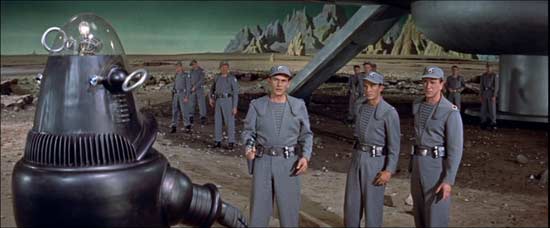
FP3 The crew are greeted by Robby. (Foreground, left to right: Jack Kelly, Warren Stevens and Leslie Nielsen). |
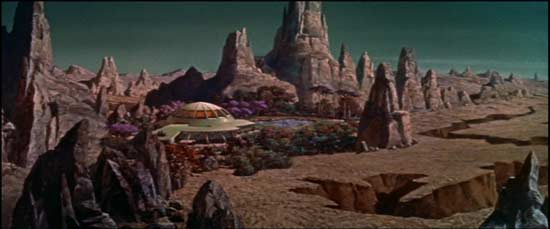
FP2 The home of Morbius – one of the splendid matte paintings used in the film.
|
Commander Adams and his crew find themselves pitted against an invisible monster with unstoppable strength that roams the planet and almost brings them to disaster. The rest of the main cast comprises Warren Stevens (Lt. ‘Doc’ Ostrow), Jack Kelly (Lt. Jerry Farman), Richard Anderson (Chief Engineer Quinn) and Earl Holliman (Cook). The movie’s writers cleverly used William Shakespeare’s The Tempest for the plot, replacing Shakespeare’s sailboat for a spaceship and the remote island of the original with a remote and distant planet. Shakespeare’s characters Prospero, Miranda and Ariel are the new residents of Altair IV in the guise of Morbius, Altaira and Robby.
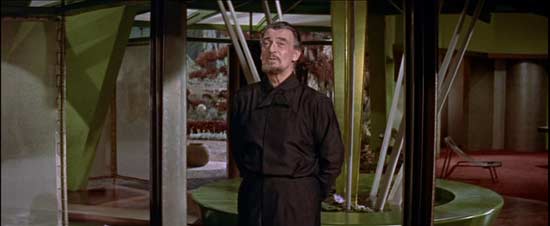
FP3A Morbius himself...(Walter Pidgeon) |
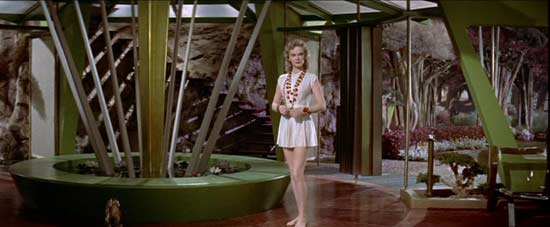
FP4 ...And his daughter, Altaira (Anne Francis) |
One of thirteen pictures produced in CinemaScope during 1956 by MGM, Forbidden Planet was the first film to be set entirely off-world. Not one section of the story takes place on the planet Earth and that of course meant that every scene had to have specially designed and constructed set, props and costumes. Art direction on the movie was in the extremely capable hands of Cedric Gibbons and Arthur Lonergan. Gibbons is without doubt the most prolific art director Hollywood ever saw. He was supervising art director at MGM for a period of 32 years, notching up the remarkable total of 1,500 movies, with direct charge of 150 of them. During this long career he was also the man responsible for designing the Academy Award “Oscar” and was himself nominated 37 times - collecting his own statuette on 11 occasions! Forbidden Planet producer Nicholas Nayfack (who was also the producer of Robby’s second outing, The Invisible Boy), must have felt very comfortable that the look of the picture was in very safe hands. This was Arthur Lonergan’s first science fiction picture, although after Forbidden Planet he did art direction on the television Boris Karloff Thriller series and in 1964 worked on Robinson Crusoe.
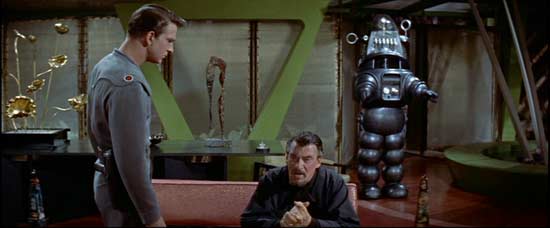
FP9 Morbius explains his discovery of the Krell, the original inhabitants of Altair IV… |
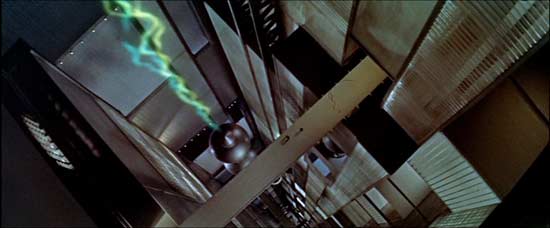
FP6A ...And their fantastic underground city. |
As neither of the two art directors credited on the film had any previous experience with a science fiction subject, the two production designers who were uncredited were most likely to have been the men responsible for the real look of the movie. Irving Block, who also wrote the screenplay for the film along with Alan Adler, had been involved with the genre from 1950 when he worked as a matte painter on Rocketship XM. His career involved him in special effects, writing and producing and other miscellaneous crew jobs on more than fifteen sci-fi and horror films from 1950 to 1959. These included Flight to Mars (1951), Unknown World (1951), World Without End (1956), Kronos (1957), The Invisible Boy (1957) and the British made Behemoth the Sea Monster (1959). So Irving Block’s involvement with science fiction must have been an important asset to the film. His co-production designer was Mentor C. Huebner, a very talented artist who did illustration and storyboard work on movies until as recently as 1997. Mentor’s credits include Dracula (1992), Dune (1984), Blade Runner (1982), The Thing (1982), Flash Gordon (1980), King Kong (1976) and The Time Machine for George Pal in 1960.
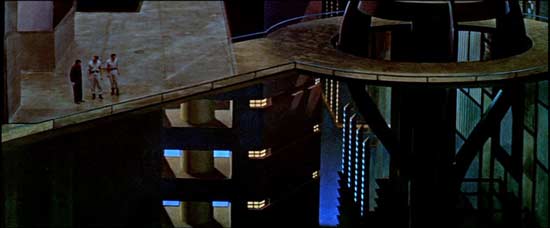
FP6B Another view of the underground city. |
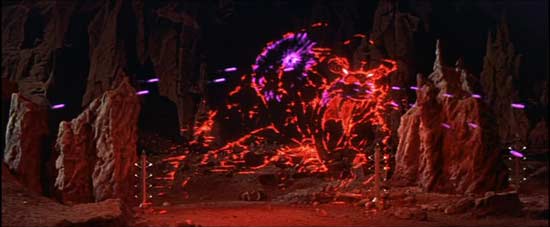
FP8 The Monster from the ID of Morbius. (animated by
Joshua Meador, on loan from Disney) |
Veteran cinematographer George J. Folsey handled the CinemaScope photography on this completely studio enclosed shoot. George had a long career with MGM and had photographed many of the classic musicals including Meet Me In St. Louis (1944), The Harvey Girls (1946), ‘Til The Clouds Roll By (1947), Take Me Out To The Ball Game (1949) Million Dollar Mermaid (1952) and Seven Brides For Seven Brothers (1954). Over his long career from 1919 (His Bridal Night) to 1976 (new sequences for That’s Entertainment Part II) George worked on over 150 movies, but Forbidden Planet was only his second science fiction film in over 30 years. The first being M.A.R.S. (1922) which was unusual for its time in that it was shot in a three-dimensional process, released after its 1922 premiere engagements under the title Radio-Mania in 1923.
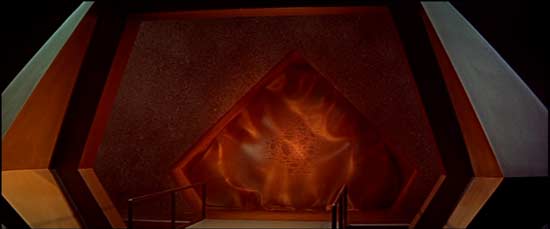
FP10 Morbius loses control of his Monster as it burns through a door… |
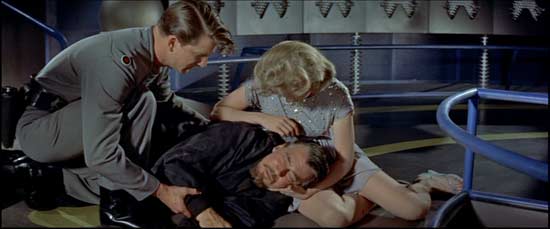
FP11 ...Which leads to his own demise. |
Director Fred McLeod Wilcox was a nephew of MGM president Louis B. Mayer and had just nine feature films to his credit when MGM assigned him to what was quite an expensive production at the time, with a budget of just under two million dollars. Forbidden Planet is his only science fiction movie, but his pacing and handling of the actors is excellent. The static sets in which he had to work to tell his story must have been a major drawback to a director more used to outdoor location shooting, but his design team gave McLeod great background visuals in which to present his story.
The amazing robot, Robby, was built in the MGM prop department and credit for his design goes to an MGM art director, Robert Kinoshita, who pushed plastics fabrication and robot design techniques into the future. The robot cost MGM $125,000 to construct. Veteran western actor, Frankie Darrow, was credited as the guiding force in bringing Robby to life, and it was he who performed inside the robot (see the following article, though). The voice of Robby belonged to Marvin Miller who later worked on a number of US television shows. At the time of my first viewing of the movie - and in fact for a great many years after that - 1 really thought that Robby was a fully-functioning mechanical creation, and had no idea that there was an actor inside the wonderful machine. Since his original outings in Forbidden Planet and The Invisible Boy, Robby surfaced again in many television shows including Lost In Space, The Thin Man, The Addams Family, Twilight Zone, Columbo, The Love Boat and Mork And Mindy, to name just a few.

Robby as a hairdresser - a publicity shot for
Forbidden Planet, with Anne Francis |
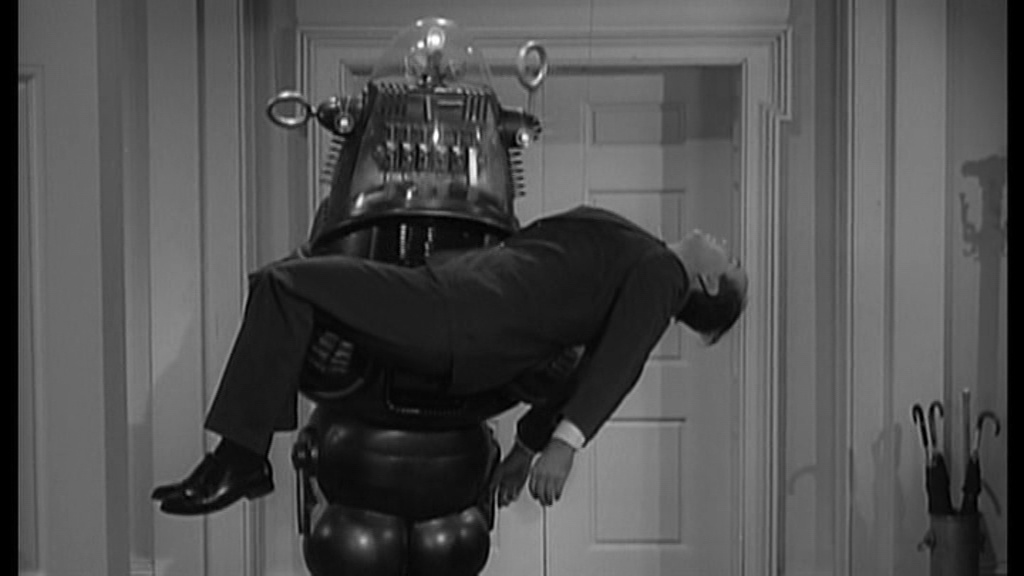
Robby in an episode of TV's The Thin Man
Another starring role for Robby in The Invisible Boy (1957),
with young Richard Eyer as Timmie Merrinoe |
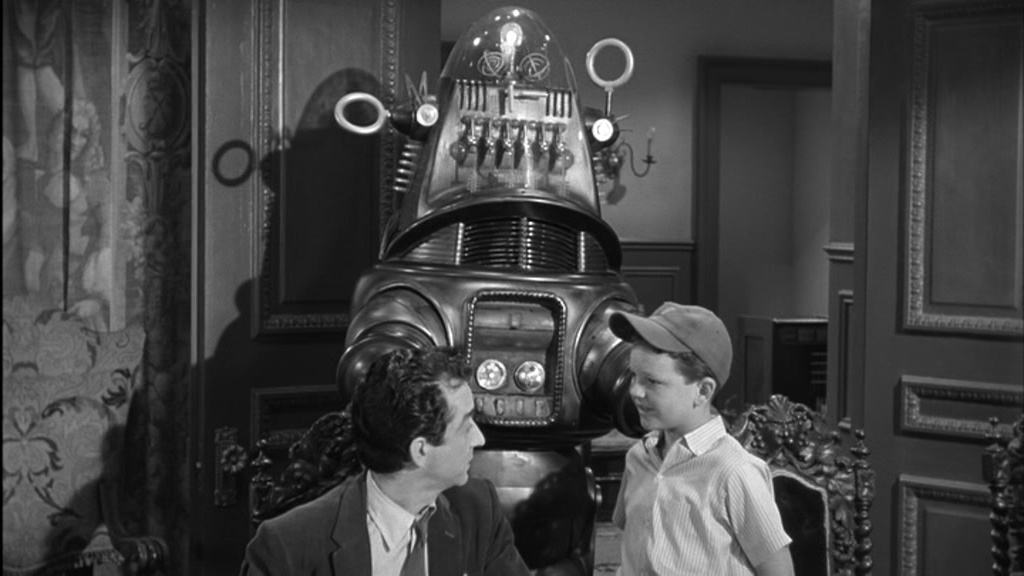
|
Forbidden Planet, with its budget of $1.9 million, was a commercial success on its original release at a time when many of the studios had jumped on to the science fiction bandwagon. The previous year had seen a number of very successful productions in the genre, including George Pal’s Conquest Of Space and two Ray Harryhausen effects pictures, The Beast From 20,000 Fathoms and It Came From Beneath The Sea. In Britain the Quatermass Xperiment had performed extremely well for Hammer Films – launching them into an ongoing specialist field of production. Forbidden Planet was released on the heels of a number of black and white science fiction films. Universal’s continuing Black Lagoon series entry, The Creature Walks Among Us, was followed by Earth Vs The Flying Saucers, from Ray Harryhausen. Roger Corman’s The Day The World Ended and Don Siegel’s amazing Invasion Of The Body Snatchers were both produced in the SuperScope process, but the grandeur of colour and CinemaScope certainly made Forbidden Planet an “event” release. It was a dazzling visual experience in its day, and has the quality production values that make it timeless for modern viewers. To see Robby and the gang on a big screen in a theatre environment is a fantastic joy not to be missed if the opportunity ever comes round again.
And to complement Harry’s Forbidden Planet piece, I thought you might like to see this timely contribution, previously published in the aforementioned Scary Dreams, and reproduced here with the kind permission of its author, the ultimate Sci-Fi and Horror fan, Tony Meadows - the man who has forgotten more than most of us know about the genre!
Robby...
Science Fiction Cinema’s most endearing robot.
by Tony Meadows
Robby - the robot from Forbidden Planet - was born in the prop shop at MGM Studios in 1956. More specifically, in the place called The Leather Shop, where they made all the tooling and forms for him. One of the biggest problems they had to contend with was in keeping the robot’s body weight down. The shop crew came up with what would be, for that time, some very hi-tech ideas to get around the problem.
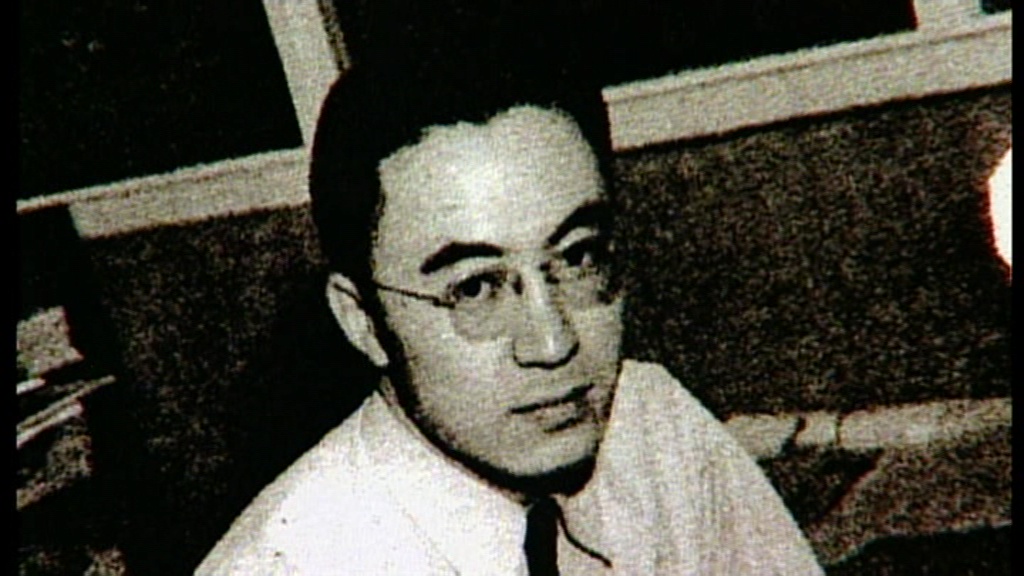
Robby's designer, Robert Kinoshita, at the MGM Studios in 1955 |
The body was originally to have been constructed from wood, but they figured that would have been too heavy, so instead, they built him out of a vacuum formed plastic called Royalite. To give Robby a realistic look, many of his parts, such as the sax-valves inside his plastic dome, were machined in metal.
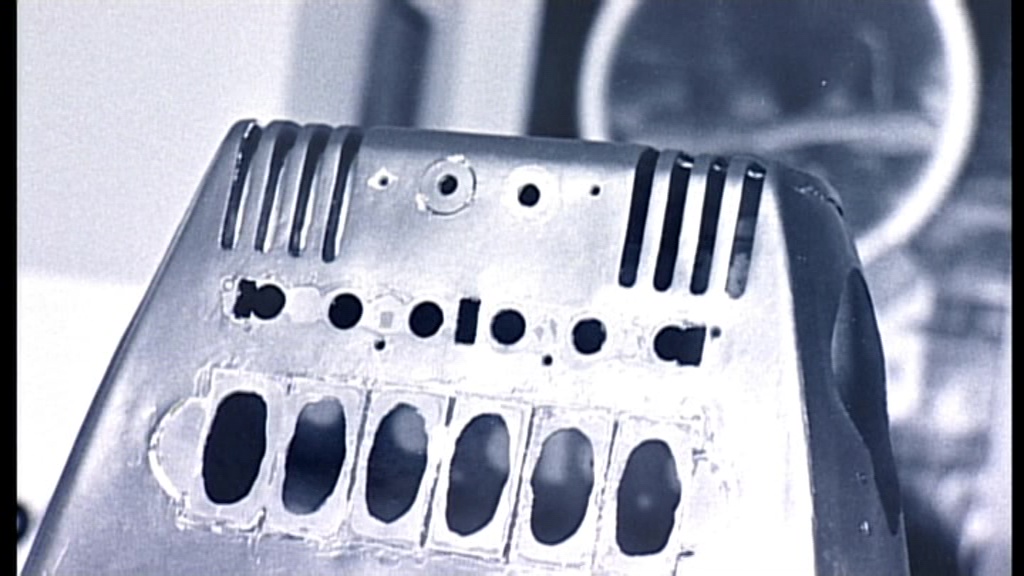
A plastic moulding for Robby's 'brain' |
Robby was actually designed for Frankie Carpenter, who was a prop builder on the film. He was to play the part of Robby. However, the crew hadn’t thought about Frankie’s union status, and the Screen Actor’s Guild stepped in and informed the studio that they would have to hire a union actor to play the robot role. To satisfy the Guild, actor Frankie Darrow was hired, and although Darrow did do some of the scenes – the prop-shop’s original Frankie did most of it! The reason for this was because it soon became apparent that Darrow had a slight drink problem.
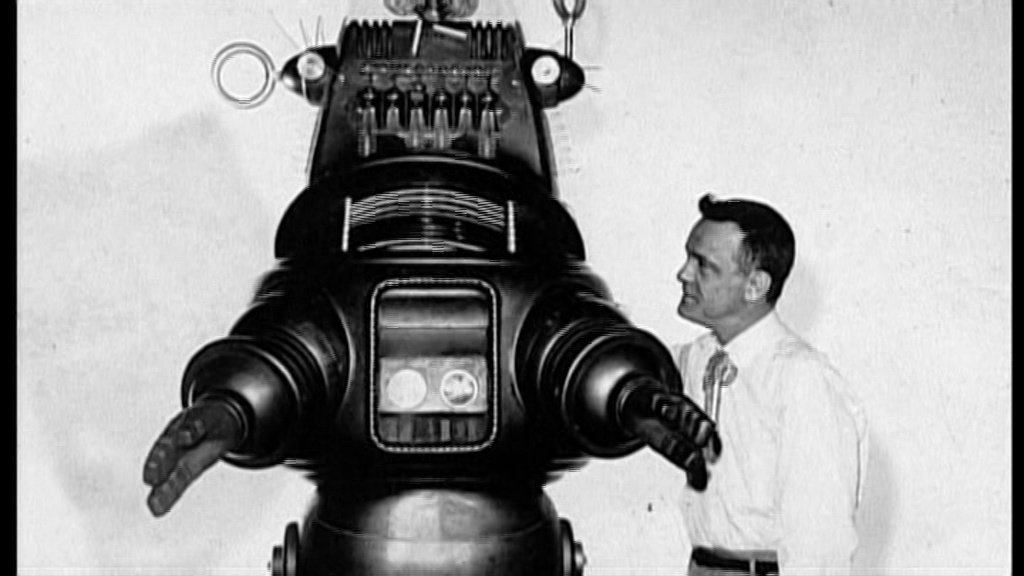
Robby with his 'inside man' Frankie Darrow |
In the first sequence, when Robby alights from the car, he repeatedly began turning through 180 degrees and the stage crew had to run around trying to catch him. They managed to stop him before he hit the ground, and dragged the inebriated Darrow out of the suit. After that incident, production continued with Carpenter in the Robby suit and Darrow remaining on the payroll to appease the actor’s union.
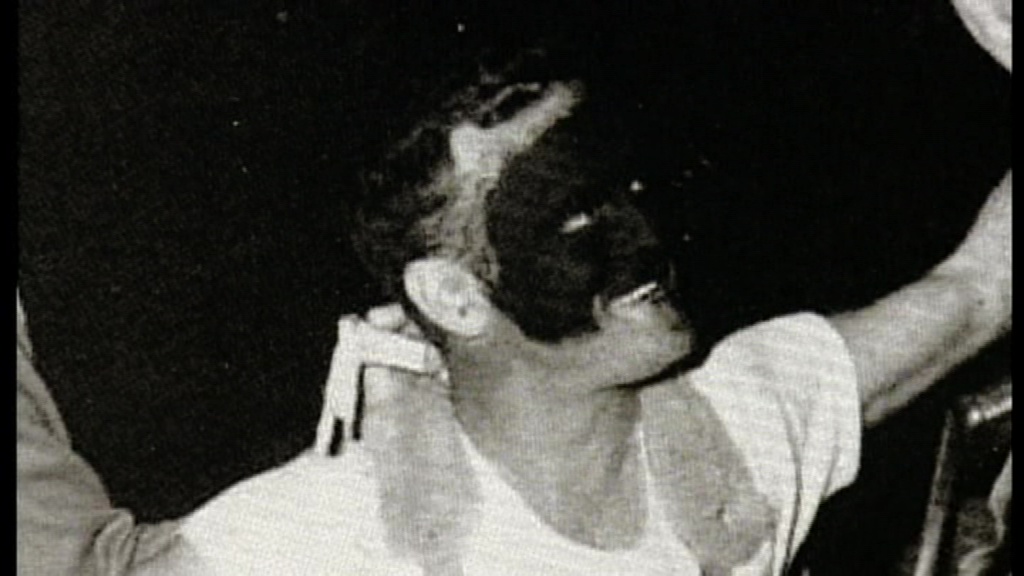
Darrow, in black make up, so his face wouldn't be visible inside Robby's brain |
Weighty Problem
Robby weighed in at almost a hundred and ten pounds, so in order to support his weight, the operator had to carry most of it on his shoulders. The upper part of Robby was, in fact, too heavy for the legs to support! This meant that Frankie Carpenter could only stay inside the robot for about twenty minutes at a time. Then, he had to be backed into a special rack - a sort of metal shelving that supported him so he could rest - and literally take the weight off his legs! The harness they used was known as a ‘flying harness’, used in such MGM films as The Wizard of Oz for the flying monkeys.
A. Arnold Gillespie, MGM’s top special effects technician for over forty years, and winner of four Academy Awards for his work, recalled in an interview in 1974 how Robby was created:
“I felt that most robots in science fiction movies had a look of a man in an aluminium suit. They all seemed the same to me and I decided that we ought to find a new look – a different kind of robot. I happened to think of the pot-bellied stoves of my youth. So, Robby was designed, basically, from an old pot-bellied coal-burning stove!”

One of the design drawings for Robby |
Hot Wired
But Robby was much more than a man in a suit. Cinematographer George Folsey described his workings like this:
“The robot’s massive body was motivated by six motors and was controlled through a complicated panel. The panel consisted of ten dials, sixteen switches and three buttons and was located off to one side of the set. He had complete mobility of arms, legs and head. More than six months of trial and error labour were required to successfully install 2,600 feet of electrical wiring that made the robot independent and self operating.”
In fact, so successful was the construction, so seamless the illusion that it was thought for a long, long time that Robby was a real robot.

Cutaway drawing of Robby's 'imagined' interior workings |
The voice of Robby was provided by a well-known announcer of the day, Marvin Miller. His other appearances, besides Forbidden Planet, were TheInvisible Boy and cameos in Hollywood Boulevard, Gremlins and Cherry2000. He also appeared on TV in two episodes of Lost in Space, The Thin Man series, The Perry Como Show and even Columbo. Robby did a publicity tour in the UK on the original release of Forbidden Planet and appeared in my home town of Wigan, at the Ritz Cinema, on 1st September 1956.

Robert Kinoshita being inducted into Pittsburgh's Robot Hall of Fame
- pictured with Robby replica builder, Fred Barton |
No one can argue against the fact that Robby is one of the best-loved robots ever to grace the silver screen. He is now one of the genuine icons of screen SF; holding his own with the likes of the Robotrix from Fritz Lang’s Metropolis, and Michael Rennie’s robot policeman, Gort, from The Day TheEarth Stood Still. Robby looks as fresh, as friendly and formidable today as he did 46 years ago when he first walked out of the Krell-trained mind of Dr Morbius.

Wave goodbye to the readers, Robby |
|

![]()